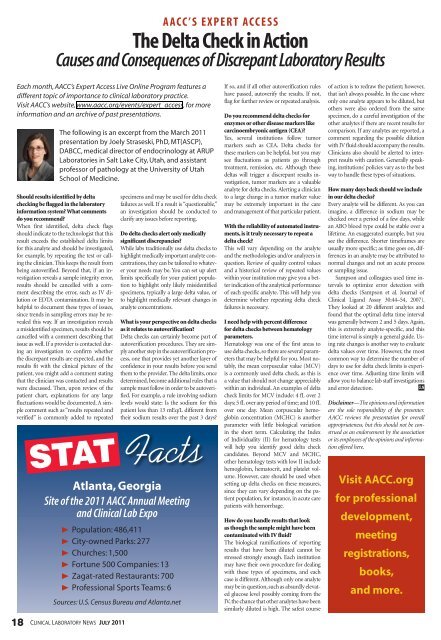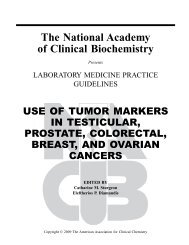Download the entire issue - American Association for Clinical ...
Download the entire issue - American Association for Clinical ...
Download the entire issue - American Association for Clinical ...
Create successful ePaper yourself
Turn your PDF publications into a flip-book with our unique Google optimized e-Paper software.
AACC’S ExPERT ACCESS<br />
The Delta Check in Action<br />
Causes and Consequences of Discrepant Laboratory Results<br />
Each month, AACC’s Expert Access Live Online Program features a<br />
different topic of importance to clinical laboratory practice.<br />
Visit AACC’s website, www.aacc.org/events/expert_access, <strong>for</strong> more<br />
in<strong>for</strong>mation and an archive of past presentations.<br />
<strong>the</strong> following is an excerpt from <strong>the</strong> March 2011<br />
presentation by Joely straseski, phd, Mt(asCp),<br />
dabCC, medical director of endocrinology at arup<br />
laboratories in salt lake City, utah, and assistant<br />
professor of pathology at <strong>the</strong> university of utah<br />
school of Medicine.<br />
Should results identified by delta<br />
checking be flagged in <strong>the</strong> laboratory<br />
in<strong>for</strong>mation system? What comments<br />
do you recommend?<br />
When first identified, delta check flags<br />
should indicate to <strong>the</strong> technologist that this<br />
result exceeds <strong>the</strong> established delta limits<br />
<strong>for</strong> this analyte and should be investigated,<br />
<strong>for</strong> example, by repeating <strong>the</strong> test or calling<br />
<strong>the</strong> clinician. This keeps <strong>the</strong> result from<br />
being autoverified. Beyond that, if an investigation<br />
reveals a sample integrity error,<br />
results should be cancelled with a comment<br />
describing <strong>the</strong> error, such as IV dilution<br />
or EDTA contamination. It may be<br />
helpful to document <strong>the</strong>se types of <strong>issue</strong>s,<br />
since trends in sampling errors may be revealed<br />
this way. If an investigation reveals<br />
a misidentified specimen, results should be<br />
cancelled with a comment describing that<br />
<strong>issue</strong> as well. If a provider is contacted during<br />
an investigation to confirm whe<strong>the</strong>r<br />
<strong>the</strong> discrepant results are expected, and <strong>the</strong><br />
results fit with <strong>the</strong> clinical picture of <strong>the</strong><br />
patient, you might add a comment stating<br />
that <strong>the</strong> clinician was contacted and results<br />
were discussed. Then, upon review of <strong>the</strong><br />
patient chart, explanations <strong>for</strong> any large<br />
fluctuations would be documented. A simple<br />
comment such as “results repeated and<br />
verified” is commonly added to repeated<br />
18 CliniCal laboratory news July 2011<br />
specimens and may be used <strong>for</strong> delta check<br />
failures as well. If a result is “questionable,”<br />
an investigation should be conducted to<br />
clarify any <strong>issue</strong>s be<strong>for</strong>e reporting.<br />
Do delta checks alert only medically<br />
significant discrepancies?<br />
While labs traditionally use delta checks to<br />
highlight medically important analyte concentrations,<br />
<strong>the</strong>y can be tailored to whatever<br />
your needs may be. You can set up alert<br />
limits specifically <strong>for</strong> your patient population<br />
to highlight only likely misidentified<br />
specimens, typically a large delta value, or<br />
to highlight medically relevant changes in<br />
analyte concentrations.<br />
What is your perspective on delta checks<br />
as it relates to autoverification?<br />
Delta checks can certainly become part of<br />
autoverification procedures. They are simply<br />
ano<strong>the</strong>r step in <strong>the</strong> autoverification process,<br />
one that provides yet ano<strong>the</strong>r layer of<br />
confidence in your results be<strong>for</strong>e you send<br />
<strong>the</strong>m to <strong>the</strong> provider. The delta limits, once<br />
determined, become additional rules that a<br />
sample must follow in order to be autoverified.<br />
For example, a rule involving sodium<br />
levels would state: Is <strong>the</strong> sodium <strong>for</strong> this<br />
patient less than 13 mEq/L different from<br />
<strong>the</strong>ir sodium results over <strong>the</strong> past 3 days?<br />
STAT Facts<br />
atlanta, Georgia<br />
Site of <strong>the</strong> 2011 AACC Annual Meeting<br />
and <strong>Clinical</strong> Lab Expo<br />
® population: 486,411<br />
® City-owned parks: 277<br />
® Churches: 1,500<br />
® <strong>for</strong>tune 500 Companies: 13<br />
® Zagat-rated restaurants: 700<br />
® professional sports teams: 6<br />
Sources: U.S. Census Bureau and Atlanta.net<br />
If so, and if all o<strong>the</strong>r autoverification rules<br />
have passed, autoverify <strong>the</strong> results. If not,<br />
flag <strong>for</strong> fur<strong>the</strong>r review or repeated analysis.<br />
Do you recommend delta checks <strong>for</strong><br />
enzymes or o<strong>the</strong>r disease markers like<br />
carcinoembryonic antigen (CEA)?<br />
Yes, several institutions follow tumor<br />
markers such as CEA. Delta checks <strong>for</strong><br />
<strong>the</strong>se markers can be helpful, but you may<br />
see fluctuations as patients go through<br />
treatment, remission, etc. Although <strong>the</strong>se<br />
deltas will trigger a discrepant results investigation,<br />
tumor markers are a valuable<br />
analyte <strong>for</strong> delta checks. Alerting a clinician<br />
to a large change in a tumor marker value<br />
may be extremely important in <strong>the</strong> care<br />
and management of that particular patient.<br />
With <strong>the</strong> reliability of automated instruments,<br />
is it truly necessary to repeat a<br />
delta check?<br />
This will vary depending on <strong>the</strong> analyte<br />
and <strong>the</strong> methodologies and/or analyzers in<br />
question. Review of quality control values<br />
and a historical review of repeated values<br />
within your institution may give you a better<br />
indication of <strong>the</strong> analytical per<strong>for</strong>mance<br />
of each specific analyte. This will help you<br />
determine whe<strong>the</strong>r repeating delta check<br />
failures is necessary.<br />
I need help with percent difference<br />
<strong>for</strong> delta checks between hematology<br />
parameters.<br />
Hematology was one of <strong>the</strong> first areas to<br />
use delta checks, so <strong>the</strong>re are several parameters<br />
that may be helpful <strong>for</strong> you. Most notably,<br />
<strong>the</strong> mean corpuscular value (MCV)<br />
is a commonly used delta check, as this is<br />
a value that should not change appreciably<br />
within an individual. An examples of delta<br />
check limits <strong>for</strong> MCV include: 4 fL over 2<br />
days; 5 fL over any period of time; and 10 fL<br />
over one day. Mean corpuscular hemoglobin<br />
concentration (MCHC) is ano<strong>the</strong>r<br />
parameter with little biological variation<br />
in <strong>the</strong> short term. Calculating <strong>the</strong> Index<br />
of Individuality (II) <strong>for</strong> hematology tests<br />
will help you identify good delta check<br />
candidates. Beyond MCV and MCHC,<br />
o<strong>the</strong>r hematology tests with low II include<br />
hemoglobin, hematocrit, and platelet volume.<br />
However, care should be used when<br />
setting up delta checks on <strong>the</strong>se measures,<br />
since <strong>the</strong>y can vary depending on <strong>the</strong> patient<br />
population, <strong>for</strong> instance, in acute care<br />
patients with hemorrhage.<br />
How do you handle results that look<br />
as though <strong>the</strong> sample might have been<br />
contaminated with IV fluid?<br />
The biological ramifications of reporting<br />
results that have been diluted cannot be<br />
stressed strongly enough. Each institution<br />
may have <strong>the</strong>ir own procedure <strong>for</strong> dealing<br />
with <strong>the</strong>se types of specimens, and each<br />
case is different. Although only one analyte<br />
may be in question, such as absurdly elevated<br />
glucose level possibly coming from <strong>the</strong><br />
IV, <strong>the</strong> chance that o<strong>the</strong>r analytes have been<br />
similarly diluted is high. The safest course<br />
of action is to redraw <strong>the</strong> patient; however,<br />
that isn’t always possible. In <strong>the</strong> case where<br />
only one analyte appears to be diluted, but<br />
o<strong>the</strong>rs were also ordered from <strong>the</strong> same<br />
specimen, do a careful investigation of <strong>the</strong><br />
o<strong>the</strong>r analytes if <strong>the</strong>re are recent results <strong>for</strong><br />
comparison. If any analytes are reported, a<br />
comment regarding <strong>the</strong> possible dilution<br />
with IV fluid should accompany <strong>the</strong> results.<br />
Clinicians also should be alerted to interpret<br />
results with caution. Generally speaking,<br />
institutions’ policies vary as to <strong>the</strong> best<br />
way to handle <strong>the</strong>se types of situations.<br />
How many days back should we include<br />
in our delta checks?<br />
Every analyte will be different. As you can<br />
imagine, a difference in sodium may be<br />
checked over a period of a few days, while<br />
an ABO blood type could be stable over a<br />
lifetime. An exaggerated example, but you<br />
see <strong>the</strong> difference. Shorter timeframes are<br />
usually more specific; as time goes on, differences<br />
in an analyte may be attributed to<br />
normal changes and not an acute process<br />
or sampling <strong>issue</strong>.<br />
Sampson and colleagues used time intervals<br />
to optimize error detection with<br />
delta checks (Sampson et al. Journal of<br />
<strong>Clinical</strong> Ligand Assay 30:44–54, 2007).<br />
They looked at 20 different analytes and<br />
found that <strong>the</strong> optimal delta time interval<br />
was generally between 2 and 5 days. Again,<br />
this is extremely analyte-specific, and this<br />
time interval is simply a general guide. Using<br />
rate changes is ano<strong>the</strong>r way to evaluate<br />
delta values over time. However, <strong>the</strong> most<br />
common way to determine <strong>the</strong> number of<br />
days to use <strong>for</strong> delta check limits is experience<br />
over time. Adjusting time limits will<br />
allow you to balance lab staff investigations<br />
and error detection. CLN<br />
Disclaimer—The opinions and in<strong>for</strong>mation<br />
are <strong>the</strong> sole responsibility of <strong>the</strong> presenter.<br />
AACC reviews <strong>the</strong> presentation <strong>for</strong> overall<br />
appropriateness, but this should not be construed<br />
as an endorsement by <strong>the</strong> association<br />
or its employees of <strong>the</strong> opinions and in<strong>for</strong>mation<br />
offered here.<br />
visit aacc.org<br />
<strong>for</strong> professional<br />
development,<br />
meeting<br />
registrations,<br />
books,<br />
and more.
















